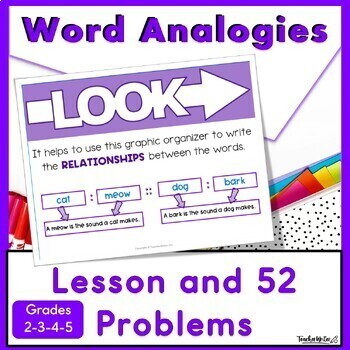Word Analogies with Graphic Organizer for Critical Thinking
- Zip
- Google Apps™

Description
Teaching word analogies couldn't be easier than with this product. It includes:
- Definition of a word analogy
- Simple word analogy examples
- An analogies worksheet template
- A graphic organizer to find the word relationships
Nine slides teach how to solve analogies. It has 52 word analogies for students in grades 3-5 to solve. You can use this year after year in multiple grade levels.
Boost critical thinking with these activities. Once your students know how to solve word analogies they'll be asking for more because it's fun.
- ***You can check out the preview to see the analogies included.***
This NO-PREP resource is in PDF, Google Slides (TM) and Powerpoint. If you only want access to the slides and not the printable or PPTx, go to this listing:
>>>>Word Analogies in Google Slides<<<<<
The word analogy critical thinking activity uses a graphic organizer that makes it simple for students learn how to find the relationships between the words. Once they find the relationship, they will have success in reading and answering a word analogy. Analogies are a great way to develop critical thinking skills in young learners.
If you print these slides four or six to a page, you have task cards!
Use these word analogy practice slides in:
- Whole class instruction
- Small group instruction
- Literacy centers
- Game day
- Homework
- Online or in person
CCSS Standards Covered:
Language Anchor Standards grades 2, 3, 4, and 5,
L.2.5 and L.3.5 Demonstrate understanding of word relationships and nuances in word meanings.
L.4.5 and L.5.5 Demonstrate understanding of figurative language, word relationships, and nuances in word meanings. and L.5.5 Demonstrate understanding of figurative language, word relationships, and nuances in word meanings.
Related Products
⭐ Word Analogy Boom Cards Critical Thinking Activity
⭐ Fact and Opinion Critical Thinking Activity Self Checking Boom Cards
⭐ Fact or Opinion Task Cards and Games
⭐ Opinion Writing Prompts and Fact or Opinion Boom Cards Bundle
⭐ Capitalization and Punctuation Worksheets and ELA Escape Room Activity Grade 3-4
➤Who this is for:
▶️2nd grade
▶️3rd grade
▶️4th grade
▶️5th grade
➤What this resource includes:
- ✅2 pages of teacher notes and ideas for use
- ✅9 slides to teach how to solve word analogies
- ✅52 simple analogies for students to solve
- ✅A graphic organizer
- ✅Answer keys for the teacher
- ✅Extra blank printable analogy pages so you can make your own
- ⭐Check out the preview to see examples of what's included!⭐
Feedback and Follow and Earn TpT Credits to Spend
Feedback: When you leave ratings and feedback you earn TpT Credits. Did you know you can use TpT credits to purchase products at any store sitewide? It really comes in handy! If you enjoy this product, please leave me feedback.
Thank you for downloading this resource! I appreciate you!
Suzanne Teacherwriter.co
Join me on Social Media!
- Instagram: @teacherwriterco
- Pinterest: @teacherwriterco
- Blog: https://teacherwriter.co





